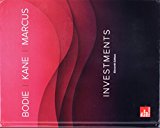
Investments, 11th Edition (exclude Access Card)
11th Edition
ISBN: 9781260201543
Author: Zvi Bodie Professor; Alex Kane; Alan J. Marcus Professor
Publisher: McGraw-Hill Education
expand_more
expand_more
format_list_bulleted
Question
Chapter 21, Problem 29PS
a.
Summary Introduction
To calculate: The delta of collar when stock price is incremented by $1.
Introduction:
Total delta: The total delta value is sum of the stock price, long call value and short call value.
b.
Summary Introduction
To explain: Effect on delta value of the portfolio when stock price is very high.
Introduction:
Total delta: The total delta value is sum of the stock price, long call value and short call value.
c.
Summary Introduction
To explain: Effect on delta value of portfolio when stock prices are decreases.
Introduction:
Total delta: The total delta value is sum of the stock price, long call value and short call value.
Expert Solution & Answer
Want to see the full answer?
Check out a sample textbook solution
Students have asked these similar questions
Finance problem solve
Need answer for this.
Need asst. pls
Chapter 21 Solutions
Investments, 11th Edition (exclude Access Card)
Ch. 21 - Prob. 1PSCh. 21 - Prob. 2PSCh. 21 - Prob. 3PSCh. 21 - Prob. 4PSCh. 21 - Prob. 5PSCh. 21 - Prob. 6PSCh. 21 - Prob. 7PSCh. 21 - Prob. 8PSCh. 21 - Prob. 9PSCh. 21 - Prob. 10PS
Ch. 21 - Prob. 11PSCh. 21 - Prob. 12PSCh. 21 - Prob. 13PSCh. 21 - Prob. 14PSCh. 21 - Prob. 15PSCh. 21 - Prob. 16PSCh. 21 - Prob. 17PSCh. 21 - Prob. 18PSCh. 21 - Prob. 19PSCh. 21 - Prob. 20PSCh. 21 - Prob. 21PSCh. 21 - Prob. 22PSCh. 21 - Prob. 23PSCh. 21 - Prob. 24PSCh. 21 - Prob. 25PSCh. 21 - Prob. 26PSCh. 21 - Prob. 27PSCh. 21 - Prob. 28PSCh. 21 - Prob. 29PSCh. 21 - Prob. 30PSCh. 21 - Prob. 31PSCh. 21 - Prob. 32PSCh. 21 - Prob. 33PSCh. 21 - Prob. 34PSCh. 21 - Prob. 35PSCh. 21 - Prob. 36PSCh. 21 - Prob. 37PSCh. 21 - Prob. 38PSCh. 21 - Prob. 39PSCh. 21 - Prob. 40PSCh. 21 - Prob. 41PSCh. 21 - Prob. 42PSCh. 21 - Prob. 43PSCh. 21 - Prob. 44PSCh. 21 - Prob. 45PSCh. 21 - Prob. 46PSCh. 21 - Prob. 47PSCh. 21 - Prob. 48PSCh. 21 - Prob. 49PSCh. 21 - Prob. 50PSCh. 21 - Prob. 51PSCh. 21 - Prob. 52PSCh. 21 - Prob. 53PSCh. 21 - Prob. 1CPCh. 21 - Prob. 2CPCh. 21 - Prob. 3CPCh. 21 - Prob. 4CPCh. 21 - Prob. 5CP
Knowledge Booster
Learn more about
Need a deep-dive on the concept behind this application? Look no further. Learn more about this topic, finance and related others by exploring similar questions and additional content below.Similar questions
arrow_back_ios
SEE MORE QUESTIONS
arrow_forward_ios
Recommended textbooks for you
 Essentials Of InvestmentsFinanceISBN:9781260013924Author:Bodie, Zvi, Kane, Alex, MARCUS, Alan J.Publisher:Mcgraw-hill Education,
Essentials Of InvestmentsFinanceISBN:9781260013924Author:Bodie, Zvi, Kane, Alex, MARCUS, Alan J.Publisher:Mcgraw-hill Education,

 Foundations Of FinanceFinanceISBN:9780134897264Author:KEOWN, Arthur J., Martin, John D., PETTY, J. WilliamPublisher:Pearson,
Foundations Of FinanceFinanceISBN:9780134897264Author:KEOWN, Arthur J., Martin, John D., PETTY, J. WilliamPublisher:Pearson, Fundamentals of Financial Management (MindTap Cou...FinanceISBN:9781337395250Author:Eugene F. Brigham, Joel F. HoustonPublisher:Cengage Learning
Fundamentals of Financial Management (MindTap Cou...FinanceISBN:9781337395250Author:Eugene F. Brigham, Joel F. HoustonPublisher:Cengage Learning Corporate Finance (The Mcgraw-hill/Irwin Series i...FinanceISBN:9780077861759Author:Stephen A. Ross Franco Modigliani Professor of Financial Economics Professor, Randolph W Westerfield Robert R. Dockson Deans Chair in Bus. Admin., Jeffrey Jaffe, Bradford D Jordan ProfessorPublisher:McGraw-Hill Education
Corporate Finance (The Mcgraw-hill/Irwin Series i...FinanceISBN:9780077861759Author:Stephen A. Ross Franco Modigliani Professor of Financial Economics Professor, Randolph W Westerfield Robert R. Dockson Deans Chair in Bus. Admin., Jeffrey Jaffe, Bradford D Jordan ProfessorPublisher:McGraw-Hill Education

Essentials Of Investments
Finance
ISBN:9781260013924
Author:Bodie, Zvi, Kane, Alex, MARCUS, Alan J.
Publisher:Mcgraw-hill Education,



Foundations Of Finance
Finance
ISBN:9780134897264
Author:KEOWN, Arthur J., Martin, John D., PETTY, J. William
Publisher:Pearson,

Fundamentals of Financial Management (MindTap Cou...
Finance
ISBN:9781337395250
Author:Eugene F. Brigham, Joel F. Houston
Publisher:Cengage Learning

Corporate Finance (The Mcgraw-hill/Irwin Series i...
Finance
ISBN:9780077861759
Author:Stephen A. Ross Franco Modigliani Professor of Financial Economics Professor, Randolph W Westerfield Robert R. Dockson Deans Chair in Bus. Admin., Jeffrey Jaffe, Bradford D Jordan Professor
Publisher:McGraw-Hill Education
Accounting for Derivatives Comprehensive Guide; Author: WallStreetMojo;https://www.youtube.com/watch?v=9D-0LoM4dy4;License: Standard YouTube License, CC-BY
Option Trading Basics-Simplest Explanation; Author: Sky View Trading;https://www.youtube.com/watch?v=joJ8mbwuYW8;License: Standard YouTube License, CC-BY